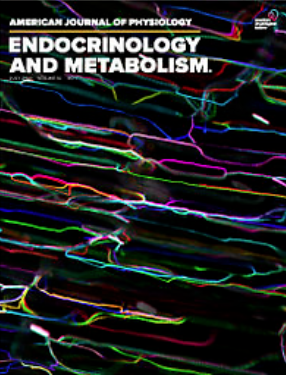Inhibition of Crif1 protects fatty acid-induced POMC neuron damage by increasing CPT-1 function
IF 4.2
2区 医学
Q1 ENDOCRINOLOGY & METABOLISM
American journal of physiology. Endocrinology and metabolism
Pub Date : 2024-04-10
DOI:10.1152/ajpendo.00420.2023
引用次数: 0
Abstract
Hypothalamic proopiomelanocortin neurons are sensors of signals that reflect the energy stores in the body. Inducing mild stress in proopiomelanocortin neurons protect them from the damage promoted by the consumption of a high-fat diet, mitigating the development of obesity; however, the cellular mechanisms behind these effects are unknown. Here, we induced mild stress in a proopiomelanocortin neuron cell line by inhibiting Crif1. In proopiomelanocortin neurons exposed to high levels of palmitate, the partial inhibition of Crif1 reverted the defects in mitochondrial respiration and ATP production; this was accompanied by improved mitochondrial fusion/fission cycling. Furthermore, the partial inhibition of Crif1 resulted in increased reactive oxygen species production, increased fatty acid oxidation, and reduced dependency on glucose for mitochondrial respiration. These changes were dependent on the activity of CPT-1. Thus, we identified a CPT-1-dependent metabolic shift towards greater utilization of fatty acids as substrates for respiration as the mechanism behind the protective effect of mild stress against palmitate-induced damage of proopiomelanocortin neurons.抑制 Crif1 可通过增加 CPT-1 的功能来保护脂肪酸诱导的 POMC 神经元损伤
下丘脑前绒毛膜促皮质素神经元是反映体内能量储存的信号传感器。诱导前绒毛膜促皮质素神经元产生轻度应激可保护它们免受高脂肪饮食的损害,从而减轻肥胖症的发展;然而,这些效应背后的细胞机制尚不清楚。在暴露于高浓度棕榈酸酯的原绒毛膜促皮质素神经元细胞系中,部分抑制 Crif1 可恢复线粒体呼吸和 ATP 生成的缺陷;同时线粒体融合/分裂循环也得到了改善。此外,部分抑制 Crif1 还导致活性氧生成增加、脂肪酸氧化增加以及线粒体呼吸对葡萄糖的依赖性降低。这些变化都依赖于 CPT-1 的活性。因此,我们确定了一种依赖于 CPT-1 的新陈代谢转变,即更多地利用脂肪酸作为呼吸底物,这是轻度应激对棕榈酸酯诱导的原绒毛膜促皮质素神经元损伤的保护作用背后的机制。
本文章由计算机程序翻译,如有差异,请以英文原文为准。
求助全文
约1分钟内获得全文
求助全文
来源期刊
CiteScore
9.80
自引率
0.00%
发文量
98
审稿时长
1 months
期刊介绍:
The American Journal of Physiology-Endocrinology and Metabolism publishes original, mechanistic studies on the physiology of endocrine and metabolic systems. Physiological, cellular, and molecular studies in whole animals or humans will be considered. Specific themes include, but are not limited to, mechanisms of hormone and growth factor action; hormonal and nutritional regulation of metabolism, inflammation, microbiome and energy balance; integrative organ cross talk; paracrine and autocrine control of endocrine cells; function and activation of hormone receptors; endocrine or metabolic control of channels, transporters, and membrane function; temporal analysis of hormone secretion and metabolism; and mathematical/kinetic modeling of metabolism. Novel molecular, immunological, or biophysical studies of hormone action are also welcome.

 求助内容:
求助内容: 应助结果提醒方式:
应助结果提醒方式:


